SITXHRM002 - Staff Rostering: Understanding NES, Awards, and Pay
VerifiedAdded on 2024/06/28
|29
|6133
|184
Homework Assignment
AI Summary
This assignment focuses on understanding staff rostering principles, award provisions, and the National Employment Standards (NES). It includes identifying leave provisions for shift workers, mandated breaks, maximum shift hours, and standard/overtime pay rates. The assignment also analyzes pay entitlements in specific scenarios, such as early closures due to unforeseen circumstances, and examines leave provisions for sick, carer's, compassionate, injury, jury service, long service, maternity/paternity, and study reasons. Furthermore, it requires completing a timesheet and payslip using provided information, including superannuation and tax calculations, and outlines the requirements for maintaining time and wage records. The student has provided a detailed overview of relevant regulations and practical applications in the context of staff rostering.
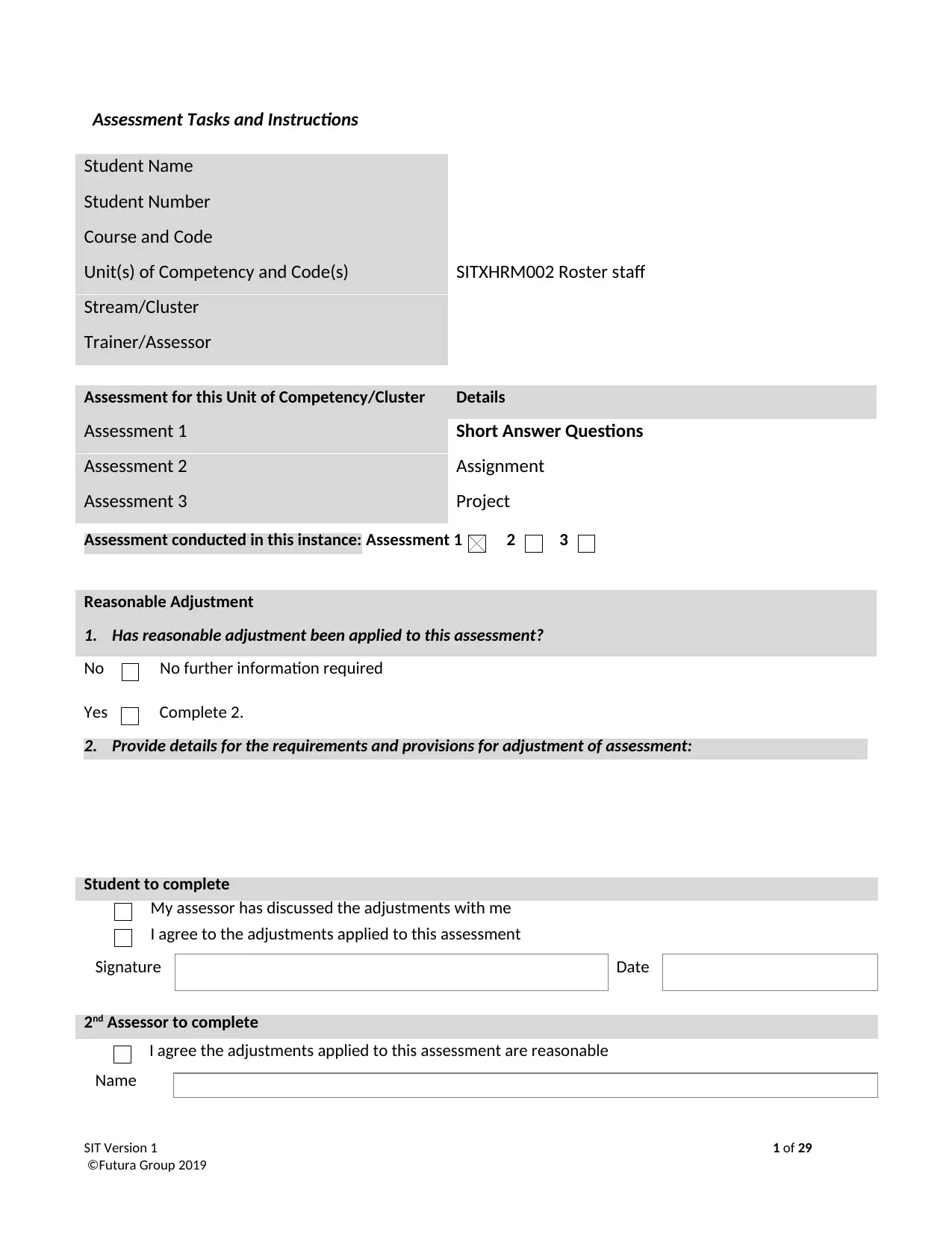
Assessment Tasks and Instructions
Student Name
Student Number
Course and Code
Unit(s) of Competency and Code(s) SITXHRM002 Roster staff
Stream/Cluster
Trainer/Assessor
Assessment for this Unit of Competency/Cluster Details
Assessment 1 Short Answer Questions
Assessment 2 Assignment
Assessment 3 Project
Assessment conducted in this instance: Assessment 1 2 3
Reasonable Adjustment
1. Has reasonable adjustment been applied to this assessment?
No No further information required
Yes Complete 2.
2. Provide details for the requirements and provisions for adjustment of assessment:
Student to complete
My assessor has discussed the adjustments with me
I agree to the adjustments applied to this assessment
Signature Date
2nd Assessor to complete
I agree the adjustments applied to this assessment are reasonable
Name
SIT Version 1 1 of 29
©Futura Group 2019
Student Name
Student Number
Course and Code
Unit(s) of Competency and Code(s) SITXHRM002 Roster staff
Stream/Cluster
Trainer/Assessor
Assessment for this Unit of Competency/Cluster Details
Assessment 1 Short Answer Questions
Assessment 2 Assignment
Assessment 3 Project
Assessment conducted in this instance: Assessment 1 2 3
Reasonable Adjustment
1. Has reasonable adjustment been applied to this assessment?
No No further information required
Yes Complete 2.
2. Provide details for the requirements and provisions for adjustment of assessment:
Student to complete
My assessor has discussed the adjustments with me
I agree to the adjustments applied to this assessment
Signature Date
2nd Assessor to complete
I agree the adjustments applied to this assessment are reasonable
Name
SIT Version 1 1 of 29
©Futura Group 2019
Paraphrase This Document
Need a fresh take? Get an instant paraphrase of this document with our AI Paraphraser
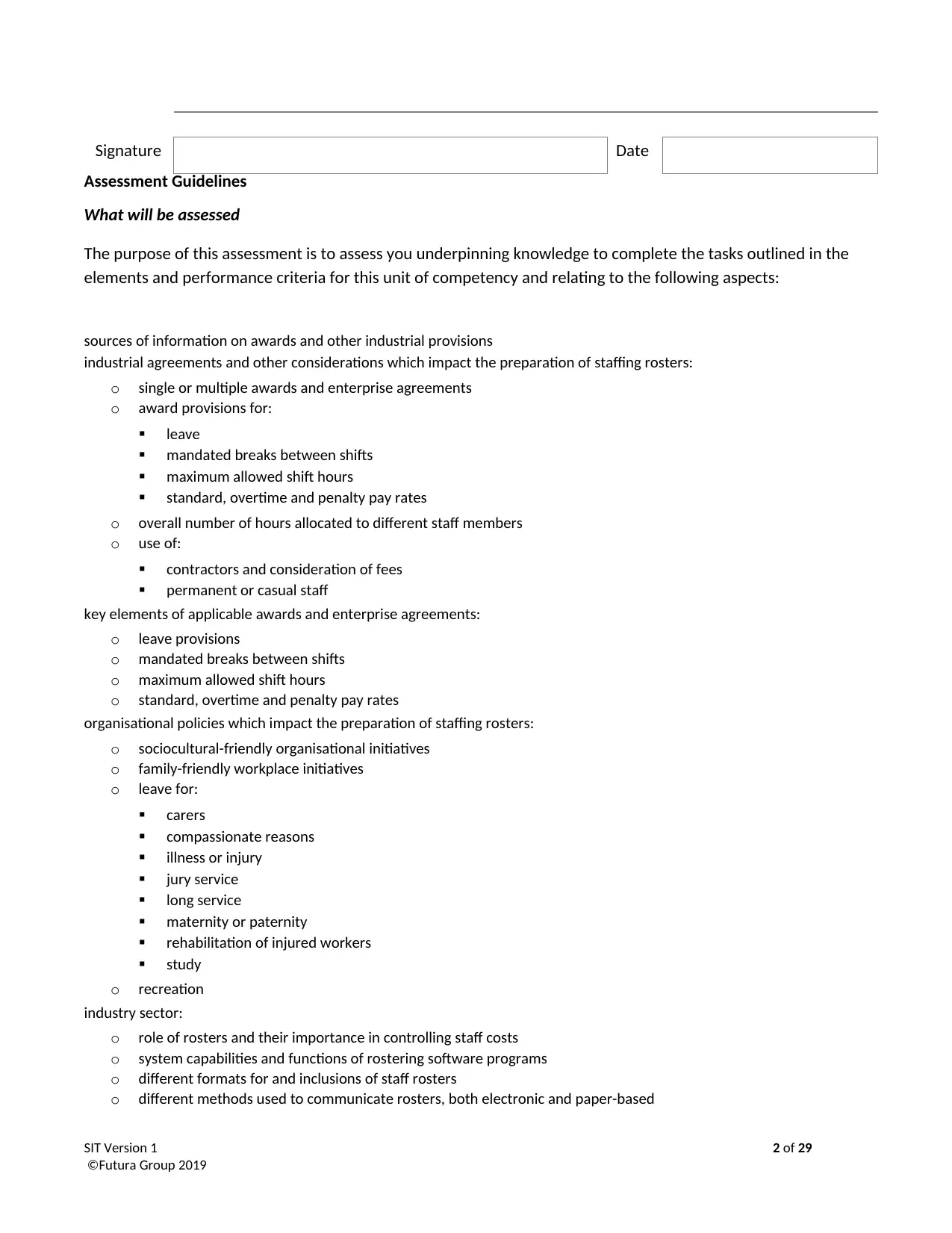
Signature Date
Assessment Guidelines
What will be assessed
The purpose of this assessment is to assess you underpinning knowledge to complete the tasks outlined in the
elements and performance criteria for this unit of competency and relating to the following aspects:
sources of information on awards and other industrial provisions
industrial agreements and other considerations which impact the preparation of staffing rosters:
o single or multiple awards and enterprise agreements
o award provisions for:
leave
mandated breaks between shifts
maximum allowed shift hours
standard, overtime and penalty pay rates
o overall number of hours allocated to different staff members
o use of:
contractors and consideration of fees
permanent or casual staff
key elements of applicable awards and enterprise agreements:
o leave provisions
o mandated breaks between shifts
o maximum allowed shift hours
o standard, overtime and penalty pay rates
organisational policies which impact the preparation of staffing rosters:
o sociocultural-friendly organisational initiatives
o family-friendly workplace initiatives
o leave for:
carers
compassionate reasons
illness or injury
jury service
long service
maternity or paternity
rehabilitation of injured workers
study
o recreation
industry sector:
o role of rosters and their importance in controlling staff costs
o system capabilities and functions of rostering software programs
o different formats for and inclusions of staff rosters
o different methods used to communicate rosters, both electronic and paper-based
SIT Version 1 2 of 29
©Futura Group 2019
Assessment Guidelines
What will be assessed
The purpose of this assessment is to assess you underpinning knowledge to complete the tasks outlined in the
elements and performance criteria for this unit of competency and relating to the following aspects:
sources of information on awards and other industrial provisions
industrial agreements and other considerations which impact the preparation of staffing rosters:
o single or multiple awards and enterprise agreements
o award provisions for:
leave
mandated breaks between shifts
maximum allowed shift hours
standard, overtime and penalty pay rates
o overall number of hours allocated to different staff members
o use of:
contractors and consideration of fees
permanent or casual staff
key elements of applicable awards and enterprise agreements:
o leave provisions
o mandated breaks between shifts
o maximum allowed shift hours
o standard, overtime and penalty pay rates
organisational policies which impact the preparation of staffing rosters:
o sociocultural-friendly organisational initiatives
o family-friendly workplace initiatives
o leave for:
carers
compassionate reasons
illness or injury
jury service
long service
maternity or paternity
rehabilitation of injured workers
study
o recreation
industry sector:
o role of rosters and their importance in controlling staff costs
o system capabilities and functions of rostering software programs
o different formats for and inclusions of staff rosters
o different methods used to communicate rosters, both electronic and paper-based
SIT Version 1 2 of 29
©Futura Group 2019
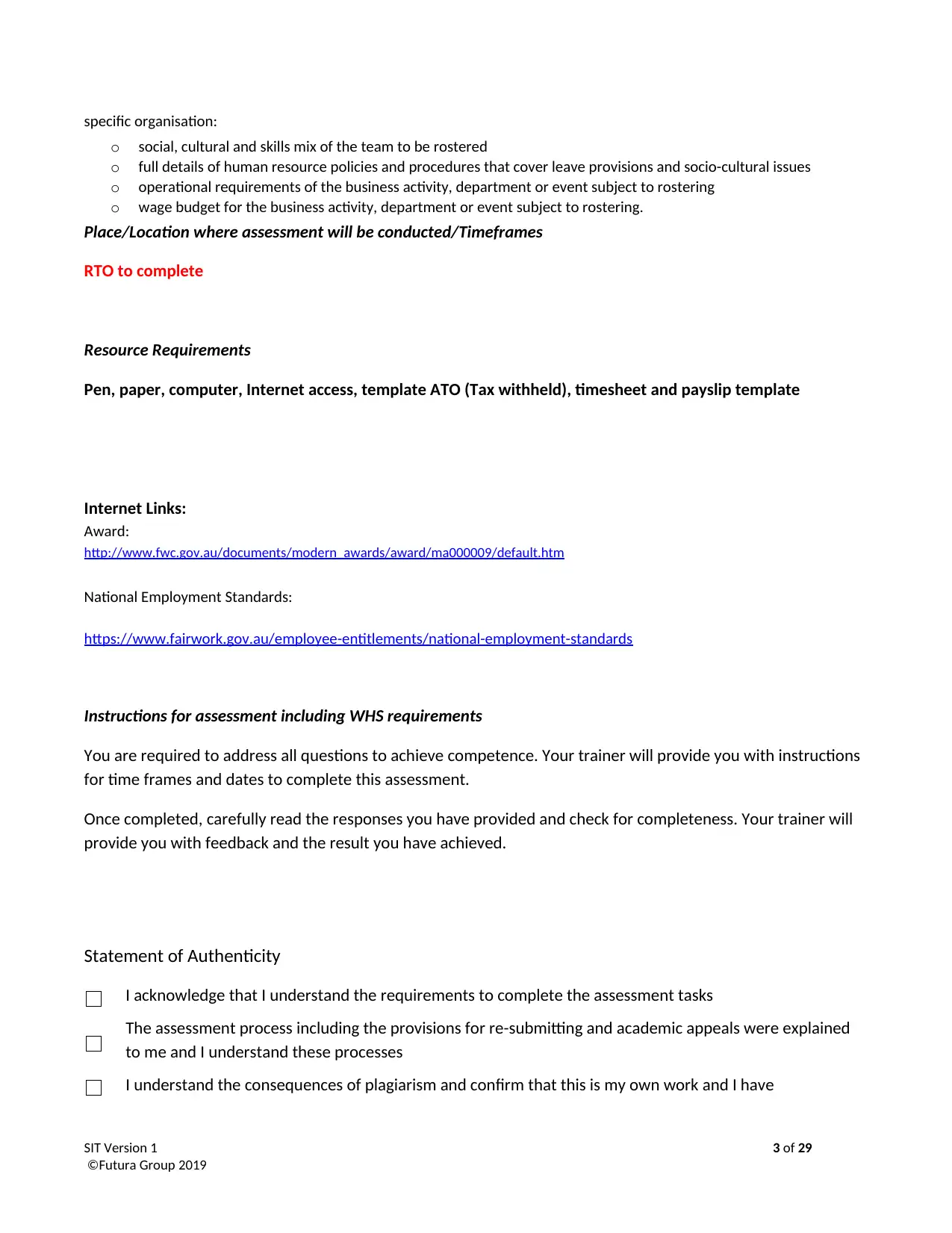
specific organisation:
o social, cultural and skills mix of the team to be rostered
o full details of human resource policies and procedures that cover leave provisions and socio-cultural issues
o operational requirements of the business activity, department or event subject to rostering
o wage budget for the business activity, department or event subject to rostering.
Place/Location where assessment will be conducted/Timeframes
RTO to complete
Resource Requirements
Pen, paper, computer, Internet access, template ATO (Tax withheld), timesheet and payslip template
Internet Links:
Award:
http://www.fwc.gov.au/documents/modern_awards/award/ma000009/default.htm
National Employment Standards:
https://www.fairwork.gov.au/employee-entitlements/national-employment-standards
Instructions for assessment including WHS requirements
You are required to address all questions to achieve competence. Your trainer will provide you with instructions
for time frames and dates to complete this assessment.
Once completed, carefully read the responses you have provided and check for completeness. Your trainer will
provide you with feedback and the result you have achieved.
Statement of Authenticity
I acknowledge that I understand the requirements to complete the assessment tasks
The assessment process including the provisions for re-submitting and academic appeals were explained
to me and I understand these processes
I understand the consequences of plagiarism and confirm that this is my own work and I have
SIT Version 1 3 of 29
©Futura Group 2019
o social, cultural and skills mix of the team to be rostered
o full details of human resource policies and procedures that cover leave provisions and socio-cultural issues
o operational requirements of the business activity, department or event subject to rostering
o wage budget for the business activity, department or event subject to rostering.
Place/Location where assessment will be conducted/Timeframes
RTO to complete
Resource Requirements
Pen, paper, computer, Internet access, template ATO (Tax withheld), timesheet and payslip template
Internet Links:
Award:
http://www.fwc.gov.au/documents/modern_awards/award/ma000009/default.htm
National Employment Standards:
https://www.fairwork.gov.au/employee-entitlements/national-employment-standards
Instructions for assessment including WHS requirements
You are required to address all questions to achieve competence. Your trainer will provide you with instructions
for time frames and dates to complete this assessment.
Once completed, carefully read the responses you have provided and check for completeness. Your trainer will
provide you with feedback and the result you have achieved.
Statement of Authenticity
I acknowledge that I understand the requirements to complete the assessment tasks
The assessment process including the provisions for re-submitting and academic appeals were explained
to me and I understand these processes
I understand the consequences of plagiarism and confirm that this is my own work and I have
SIT Version 1 3 of 29
©Futura Group 2019
⊘ This is a preview!⊘
Do you want full access?
Subscribe today to unlock all pages.

Trusted by 1+ million students worldwide
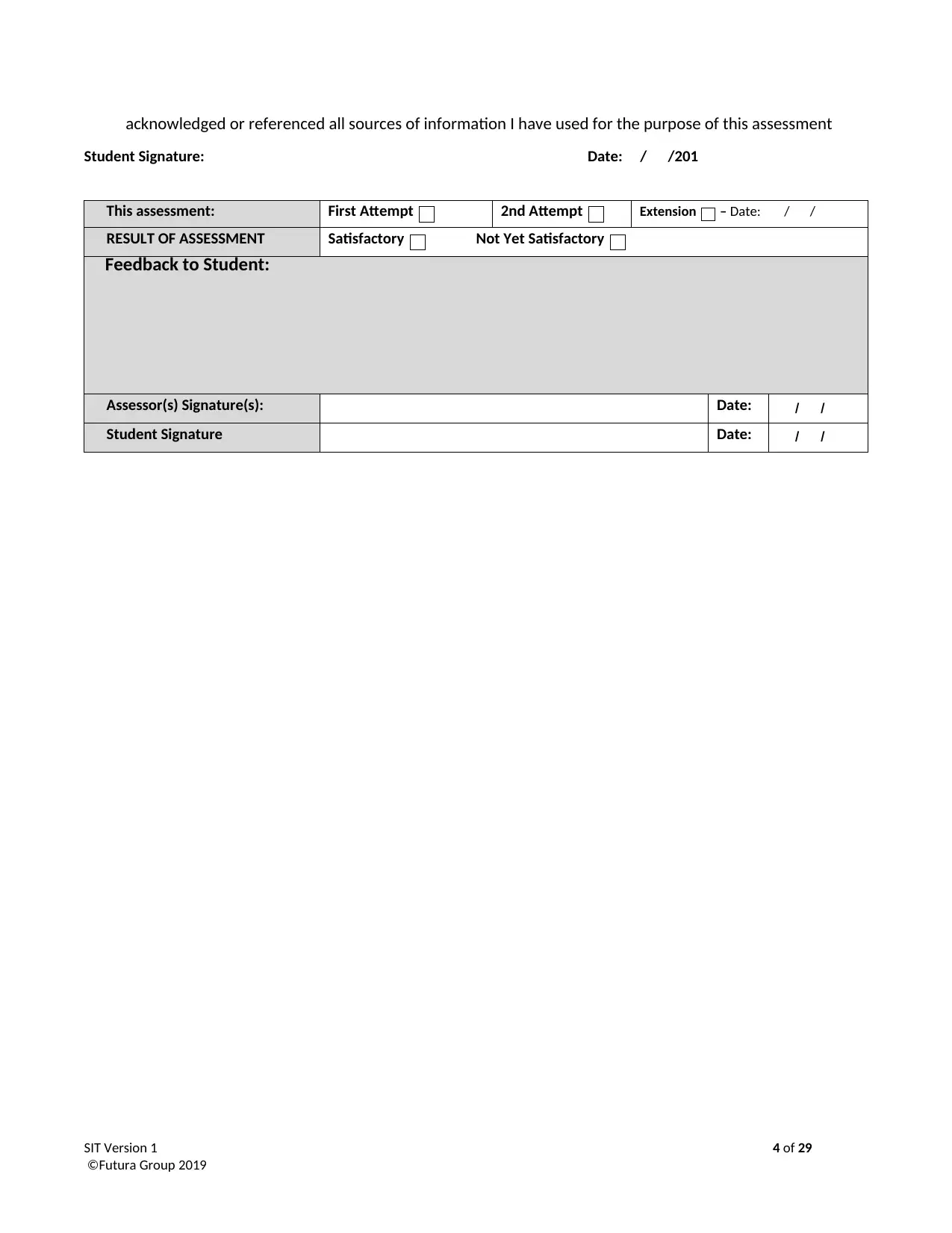
acknowledged or referenced all sources of information I have used for the purpose of this assessment
Student Signature: Date: / /201
This assessment: First Attempt 2nd Attempt Extension – Date: / /
RESULT OF ASSESSMENT Satisfactory Not Yet Satisfactory
Feedback to Student:
Assessor(s) Signature(s): Date: / /
Student Signature Date: / /
SIT Version 1 4 of 29
©Futura Group 2019
Student Signature: Date: / /201
This assessment: First Attempt 2nd Attempt Extension – Date: / /
RESULT OF ASSESSMENT Satisfactory Not Yet Satisfactory
Feedback to Student:
Assessor(s) Signature(s): Date: / /
Student Signature Date: / /
SIT Version 1 4 of 29
©Futura Group 2019
Paraphrase This Document
Need a fresh take? Get an instant paraphrase of this document with our AI Paraphraser
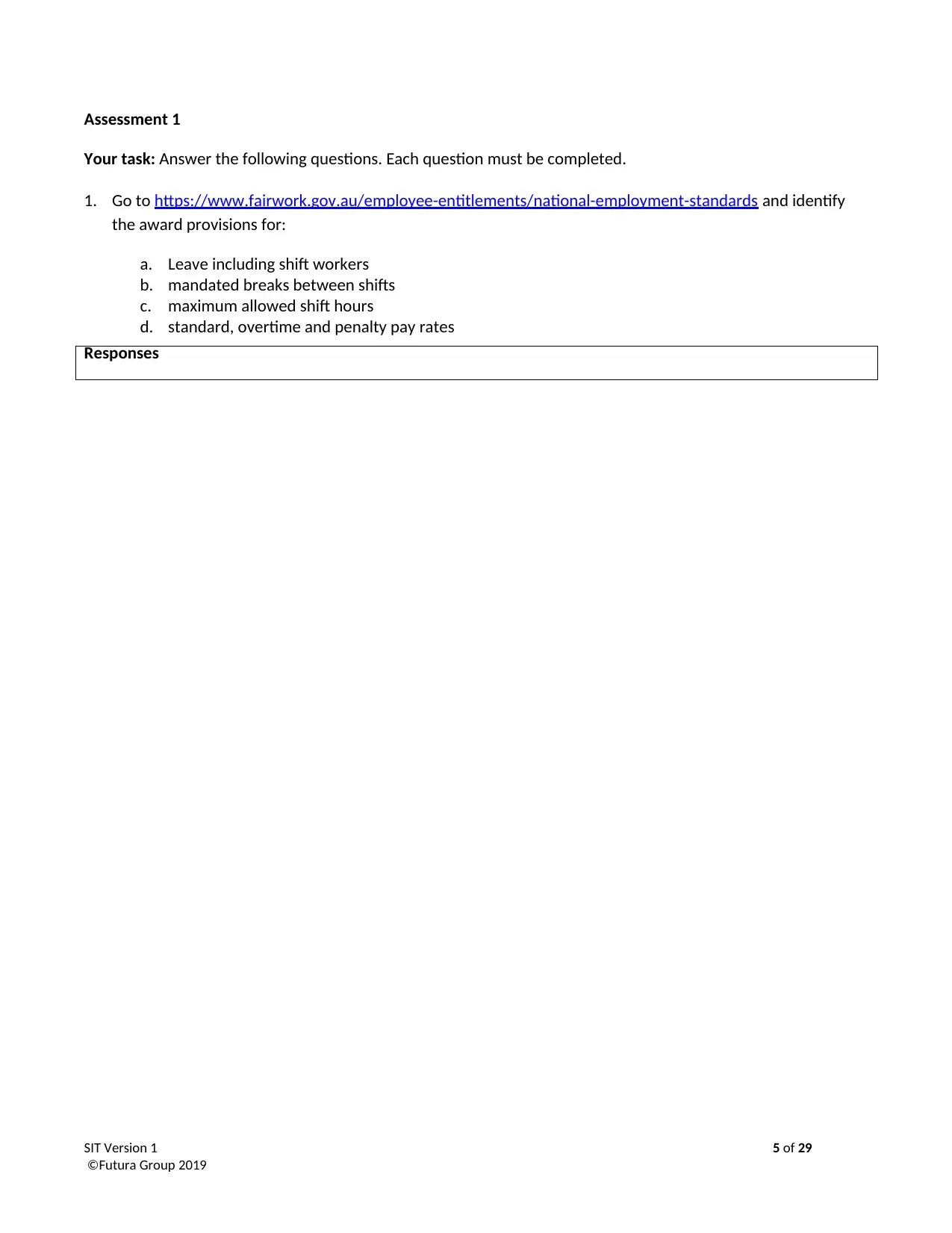
Assessment 1
Your task: Answer the following questions. Each question must be completed.
1. Go to https://www.fairwork.gov.au/employee-entitlements/national-employment-standards and identify
the award provisions for:
a. Leave including shift workers
b. mandated breaks between shifts
c. maximum allowed shift hours
d. standard, overtime and penalty pay rates
Responses
SIT Version 1 5 of 29
©Futura Group 2019
Your task: Answer the following questions. Each question must be completed.
1. Go to https://www.fairwork.gov.au/employee-entitlements/national-employment-standards and identify
the award provisions for:
a. Leave including shift workers
b. mandated breaks between shifts
c. maximum allowed shift hours
d. standard, overtime and penalty pay rates
Responses
SIT Version 1 5 of 29
©Futura Group 2019
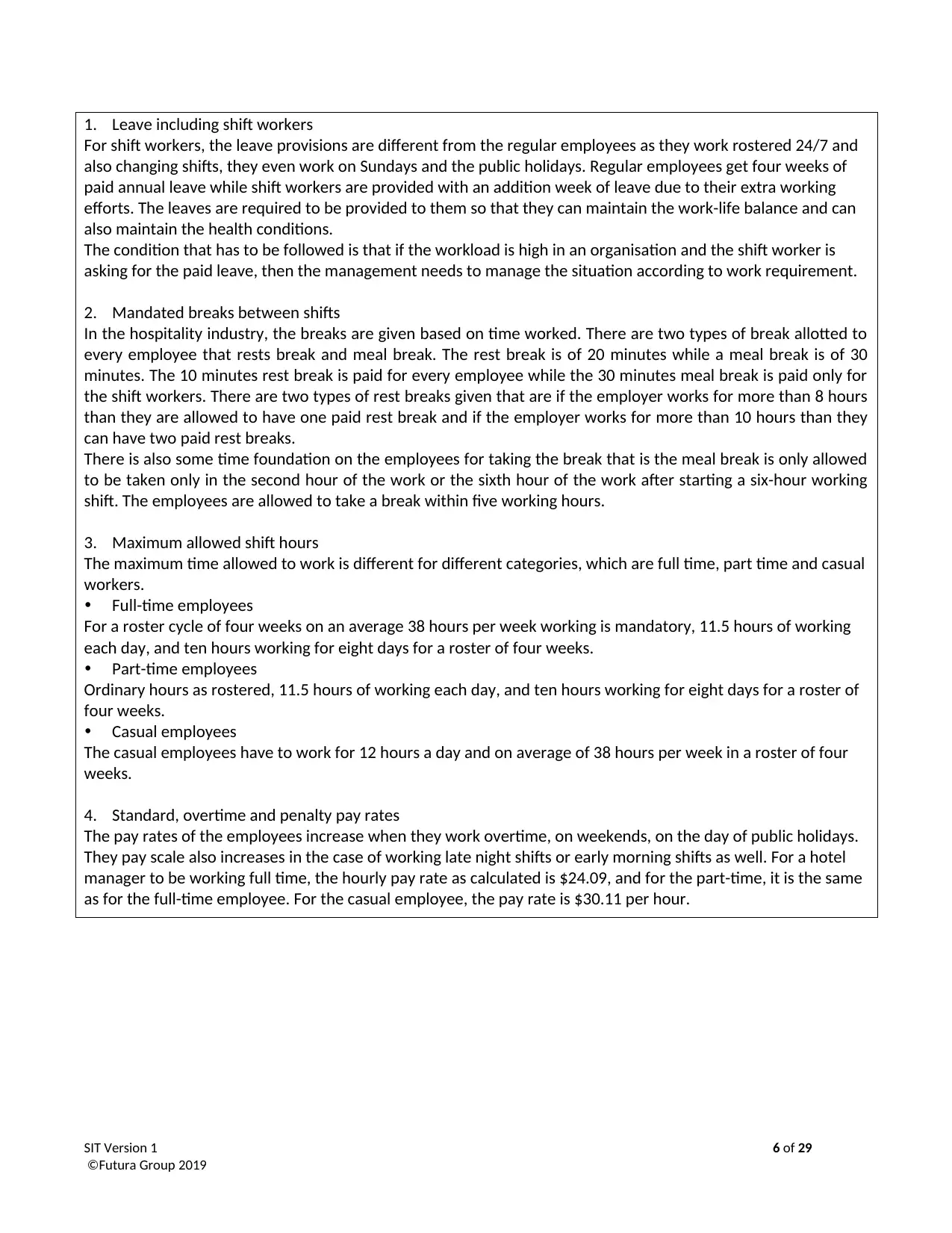
1. Leave including shift workers
For shift workers, the leave provisions are different from the regular employees as they work rostered 24/7 and
also changing shifts, they even work on Sundays and the public holidays. Regular employees get four weeks of
paid annual leave while shift workers are provided with an addition week of leave due to their extra working
efforts. The leaves are required to be provided to them so that they can maintain the work-life balance and can
also maintain the health conditions.
The condition that has to be followed is that if the workload is high in an organisation and the shift worker is
asking for the paid leave, then the management needs to manage the situation according to work requirement.
2. Mandated breaks between shifts
In the hospitality industry, the breaks are given based on time worked. There are two types of break allotted to
every employee that rests break and meal break. The rest break is of 20 minutes while a meal break is of 30
minutes. The 10 minutes rest break is paid for every employee while the 30 minutes meal break is paid only for
the shift workers. There are two types of rest breaks given that are if the employer works for more than 8 hours
than they are allowed to have one paid rest break and if the employer works for more than 10 hours than they
can have two paid rest breaks.
There is also some time foundation on the employees for taking the break that is the meal break is only allowed
to be taken only in the second hour of the work or the sixth hour of the work after starting a six-hour working
shift. The employees are allowed to take a break within five working hours.
3. Maximum allowed shift hours
The maximum time allowed to work is different for different categories, which are full time, part time and casual
workers.
Full-time employees
For a roster cycle of four weeks on an average 38 hours per week working is mandatory, 11.5 hours of working
each day, and ten hours working for eight days for a roster of four weeks.
Part-time employees
Ordinary hours as rostered, 11.5 hours of working each day, and ten hours working for eight days for a roster of
four weeks.
Casual employees
The casual employees have to work for 12 hours a day and on average of 38 hours per week in a roster of four
weeks.
4. Standard, overtime and penalty pay rates
The pay rates of the employees increase when they work overtime, on weekends, on the day of public holidays.
They pay scale also increases in the case of working late night shifts or early morning shifts as well. For a hotel
manager to be working full time, the hourly pay rate as calculated is $24.09, and for the part-time, it is the same
as for the full-time employee. For the casual employee, the pay rate is $30.11 per hour.
SIT Version 1 6 of 29
©Futura Group 2019
For shift workers, the leave provisions are different from the regular employees as they work rostered 24/7 and
also changing shifts, they even work on Sundays and the public holidays. Regular employees get four weeks of
paid annual leave while shift workers are provided with an addition week of leave due to their extra working
efforts. The leaves are required to be provided to them so that they can maintain the work-life balance and can
also maintain the health conditions.
The condition that has to be followed is that if the workload is high in an organisation and the shift worker is
asking for the paid leave, then the management needs to manage the situation according to work requirement.
2. Mandated breaks between shifts
In the hospitality industry, the breaks are given based on time worked. There are two types of break allotted to
every employee that rests break and meal break. The rest break is of 20 minutes while a meal break is of 30
minutes. The 10 minutes rest break is paid for every employee while the 30 minutes meal break is paid only for
the shift workers. There are two types of rest breaks given that are if the employer works for more than 8 hours
than they are allowed to have one paid rest break and if the employer works for more than 10 hours than they
can have two paid rest breaks.
There is also some time foundation on the employees for taking the break that is the meal break is only allowed
to be taken only in the second hour of the work or the sixth hour of the work after starting a six-hour working
shift. The employees are allowed to take a break within five working hours.
3. Maximum allowed shift hours
The maximum time allowed to work is different for different categories, which are full time, part time and casual
workers.
Full-time employees
For a roster cycle of four weeks on an average 38 hours per week working is mandatory, 11.5 hours of working
each day, and ten hours working for eight days for a roster of four weeks.
Part-time employees
Ordinary hours as rostered, 11.5 hours of working each day, and ten hours working for eight days for a roster of
four weeks.
Casual employees
The casual employees have to work for 12 hours a day and on average of 38 hours per week in a roster of four
weeks.
4. Standard, overtime and penalty pay rates
The pay rates of the employees increase when they work overtime, on weekends, on the day of public holidays.
They pay scale also increases in the case of working late night shifts or early morning shifts as well. For a hotel
manager to be working full time, the hourly pay rate as calculated is $24.09, and for the part-time, it is the same
as for the full-time employee. For the casual employee, the pay rate is $30.11 per hour.
SIT Version 1 6 of 29
©Futura Group 2019
⊘ This is a preview!⊘
Do you want full access?
Subscribe today to unlock all pages.

Trusted by 1+ million students worldwide
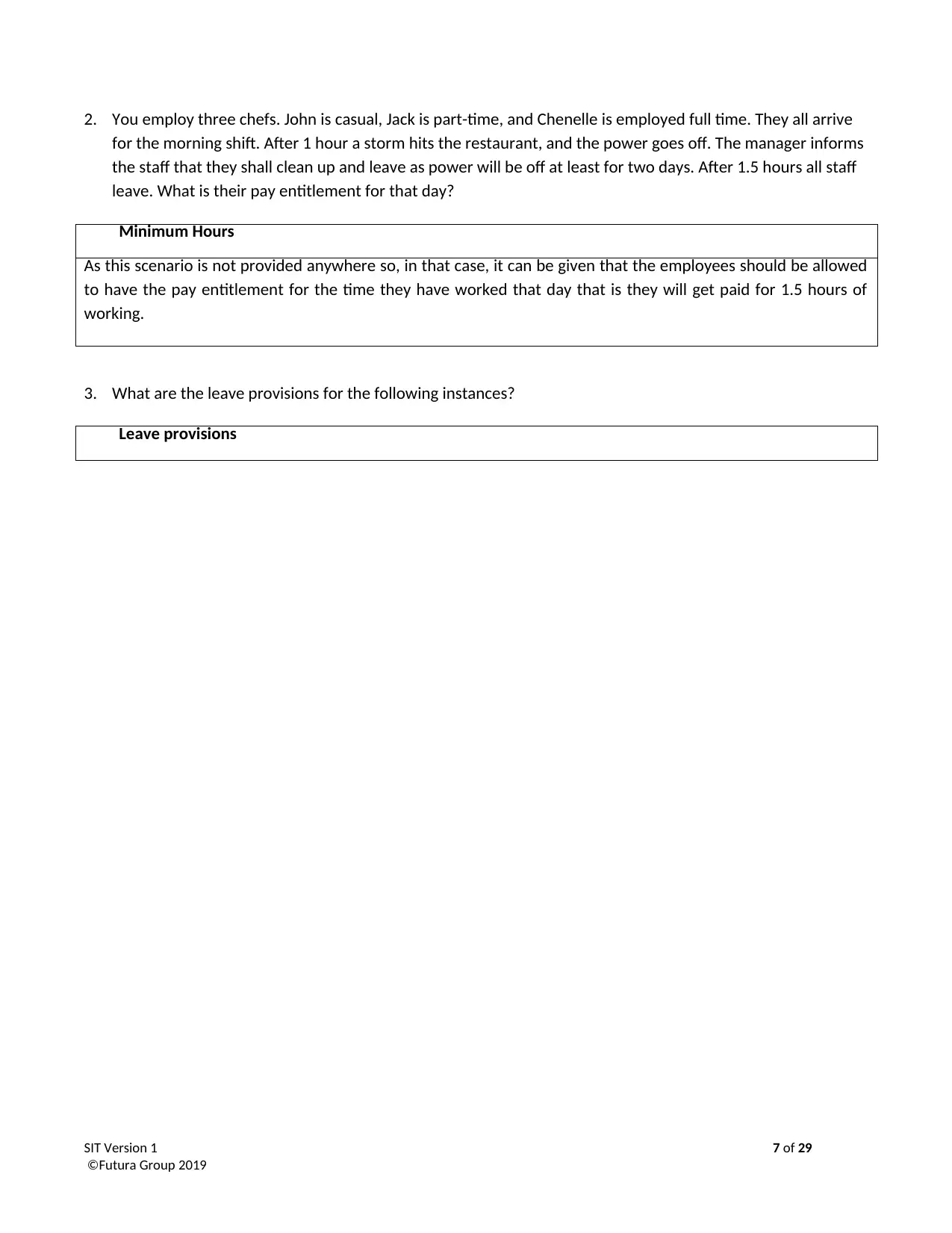
2. You employ three chefs. John is casual, Jack is part-time, and Chenelle is employed full time. They all arrive
for the morning shift. After 1 hour a storm hits the restaurant, and the power goes off. The manager informs
the staff that they shall clean up and leave as power will be off at least for two days. After 1.5 hours all staff
leave. What is their pay entitlement for that day?
Minimum Hours
As this scenario is not provided anywhere so, in that case, it can be given that the employees should be allowed
to have the pay entitlement for the time they have worked that day that is they will get paid for 1.5 hours of
working.
3. What are the leave provisions for the following instances?
Leave provisions
SIT Version 1 7 of 29
©Futura Group 2019
for the morning shift. After 1 hour a storm hits the restaurant, and the power goes off. The manager informs
the staff that they shall clean up and leave as power will be off at least for two days. After 1.5 hours all staff
leave. What is their pay entitlement for that day?
Minimum Hours
As this scenario is not provided anywhere so, in that case, it can be given that the employees should be allowed
to have the pay entitlement for the time they have worked that day that is they will get paid for 1.5 hours of
working.
3. What are the leave provisions for the following instances?
Leave provisions
SIT Version 1 7 of 29
©Futura Group 2019
Paraphrase This Document
Need a fresh take? Get an instant paraphrase of this document with our AI Paraphraser
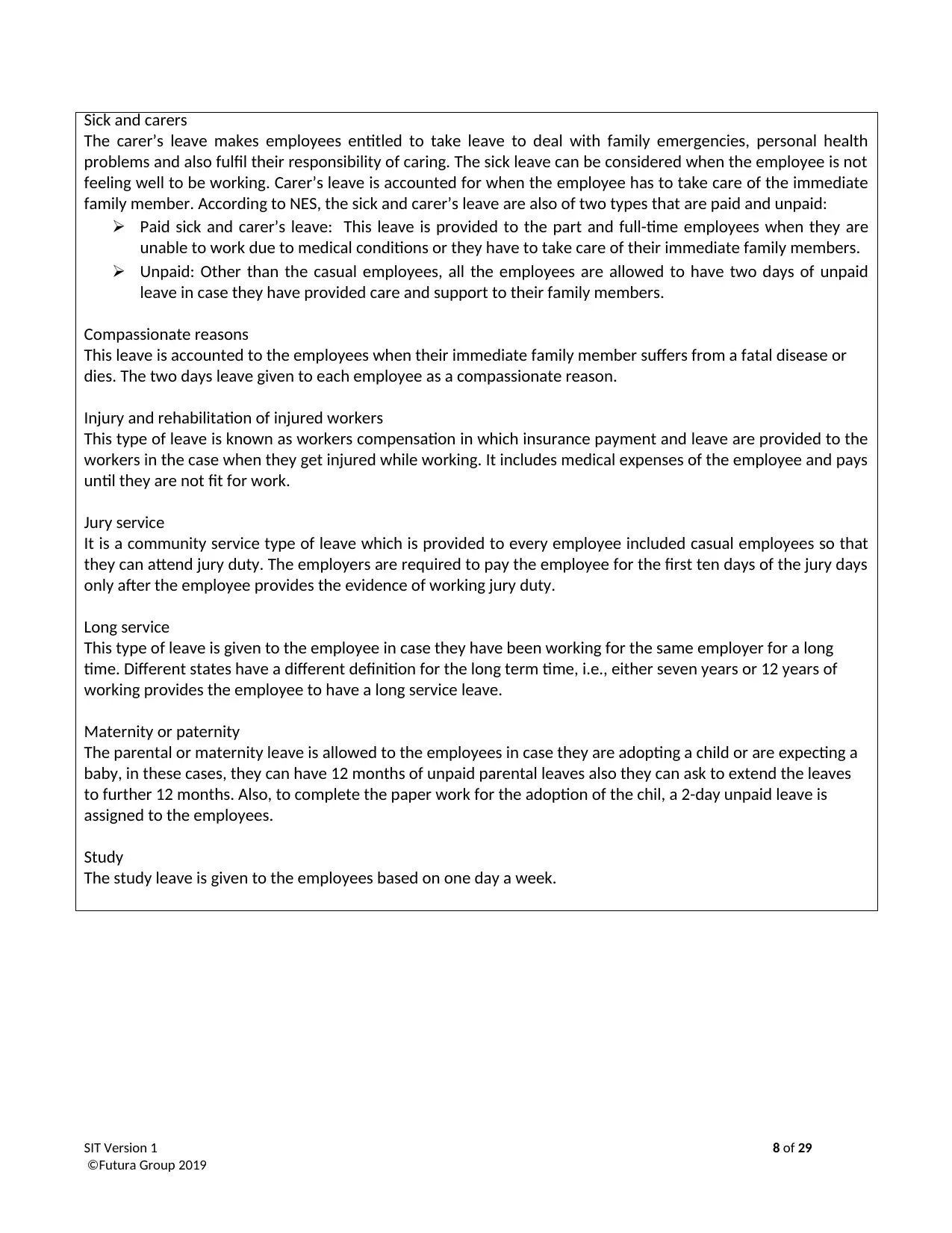
Sick and carers
The carer’s leave makes employees entitled to take leave to deal with family emergencies, personal health
problems and also fulfil their responsibility of caring. The sick leave can be considered when the employee is not
feeling well to be working. Carer’s leave is accounted for when the employee has to take care of the immediate
family member. According to NES, the sick and carer’s leave are also of two types that are paid and unpaid:
Paid sick and carer’s leave: This leave is provided to the part and full-time employees when they are
unable to work due to medical conditions or they have to take care of their immediate family members.
Unpaid: Other than the casual employees, all the employees are allowed to have two days of unpaid
leave in case they have provided care and support to their family members.
Compassionate reasons
This leave is accounted to the employees when their immediate family member suffers from a fatal disease or
dies. The two days leave given to each employee as a compassionate reason.
Injury and rehabilitation of injured workers
This type of leave is known as workers compensation in which insurance payment and leave are provided to the
workers in the case when they get injured while working. It includes medical expenses of the employee and pays
until they are not fit for work.
Jury service
It is a community service type of leave which is provided to every employee included casual employees so that
they can attend jury duty. The employers are required to pay the employee for the first ten days of the jury days
only after the employee provides the evidence of working jury duty.
Long service
This type of leave is given to the employee in case they have been working for the same employer for a long
time. Different states have a different definition for the long term time, i.e., either seven years or 12 years of
working provides the employee to have a long service leave.
Maternity or paternity
The parental or maternity leave is allowed to the employees in case they are adopting a child or are expecting a
baby, in these cases, they can have 12 months of unpaid parental leaves also they can ask to extend the leaves
to further 12 months. Also, to complete the paper work for the adoption of the chil, a 2-day unpaid leave is
assigned to the employees.
Study
The study leave is given to the employees based on one day a week.
SIT Version 1 8 of 29
©Futura Group 2019
The carer’s leave makes employees entitled to take leave to deal with family emergencies, personal health
problems and also fulfil their responsibility of caring. The sick leave can be considered when the employee is not
feeling well to be working. Carer’s leave is accounted for when the employee has to take care of the immediate
family member. According to NES, the sick and carer’s leave are also of two types that are paid and unpaid:
Paid sick and carer’s leave: This leave is provided to the part and full-time employees when they are
unable to work due to medical conditions or they have to take care of their immediate family members.
Unpaid: Other than the casual employees, all the employees are allowed to have two days of unpaid
leave in case they have provided care and support to their family members.
Compassionate reasons
This leave is accounted to the employees when their immediate family member suffers from a fatal disease or
dies. The two days leave given to each employee as a compassionate reason.
Injury and rehabilitation of injured workers
This type of leave is known as workers compensation in which insurance payment and leave are provided to the
workers in the case when they get injured while working. It includes medical expenses of the employee and pays
until they are not fit for work.
Jury service
It is a community service type of leave which is provided to every employee included casual employees so that
they can attend jury duty. The employers are required to pay the employee for the first ten days of the jury days
only after the employee provides the evidence of working jury duty.
Long service
This type of leave is given to the employee in case they have been working for the same employer for a long
time. Different states have a different definition for the long term time, i.e., either seven years or 12 years of
working provides the employee to have a long service leave.
Maternity or paternity
The parental or maternity leave is allowed to the employees in case they are adopting a child or are expecting a
baby, in these cases, they can have 12 months of unpaid parental leaves also they can ask to extend the leaves
to further 12 months. Also, to complete the paper work for the adoption of the chil, a 2-day unpaid leave is
assigned to the employees.
Study
The study leave is given to the employees based on one day a week.
SIT Version 1 8 of 29
©Futura Group 2019
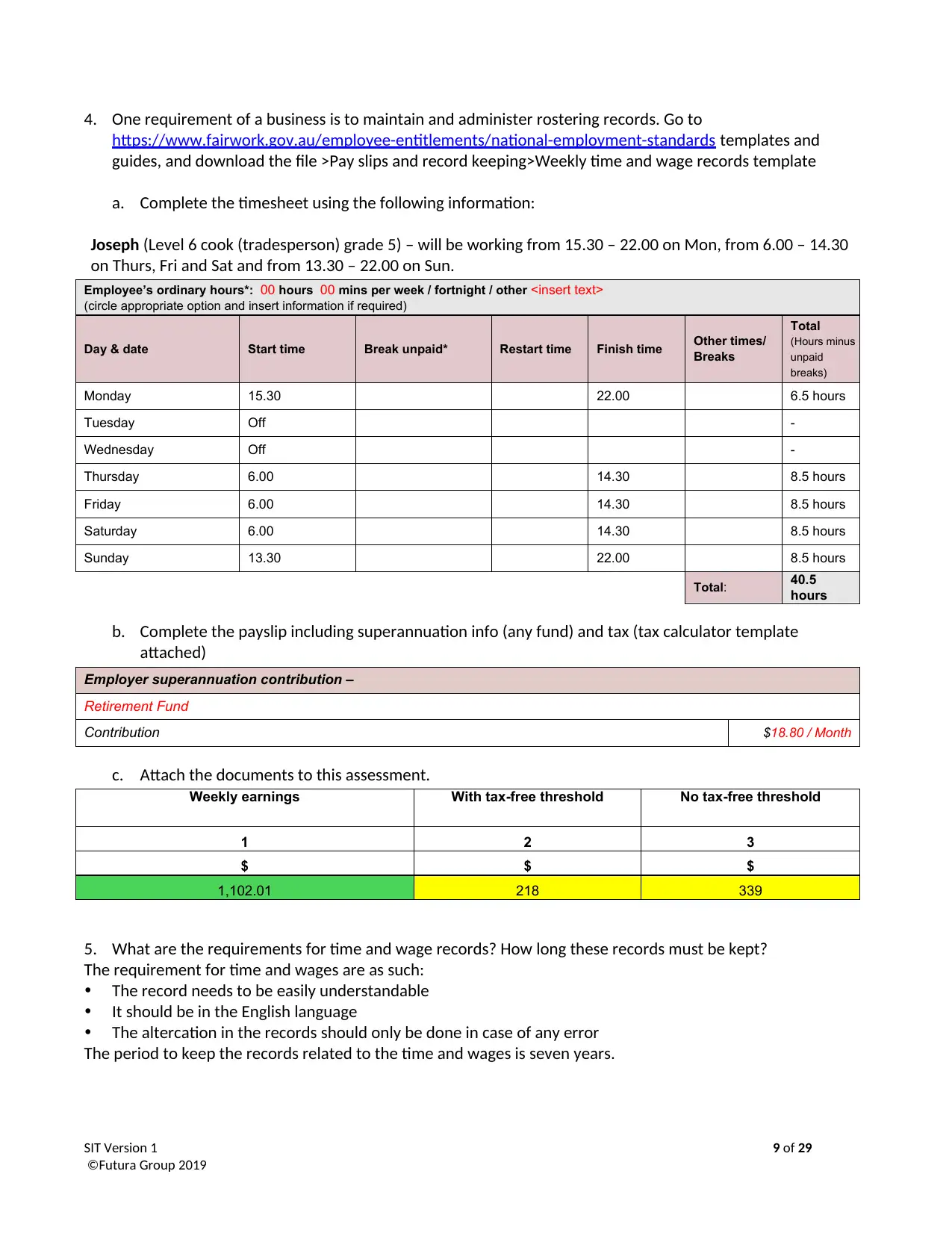
4. One requirement of a business is to maintain and administer rostering records. Go to
https://www.fairwork.gov.au/employee-entitlements/national-employment-standards templates and
guides, and download the file >Pay slips and record keeping>Weekly time and wage records template
a. Complete the timesheet using the following information:
Joseph (Level 6 cook (tradesperson) grade 5) – will be working from 15.30 – 22.00 on Mon, from 6.00 – 14.30
on Thurs, Fri and Sat and from 13.30 – 22.00 on Sun.
Employee’s ordinary hours*: 00 hours 00 mins per week / fortnight / other <insert text>
(circle appropriate option and insert information if required)
Day & date Start time Break unpaid* Restart time Finish time Other times/
Breaks
Total
(Hours minus
unpaid
breaks)
Monday 15.30 22.00 6.5 hours
Tuesday Off -
Wednesday Off -
Thursday 6.00 14.30 8.5 hours
Friday 6.00 14.30 8.5 hours
Saturday 6.00 14.30 8.5 hours
Sunday 13.30 22.00 8.5 hours
Total: 40.5
hours
b. Complete the payslip including superannuation info (any fund) and tax (tax calculator template
attached)
Employer superannuation contribution –
Retirement Fund
Contribution $18.80 / Month
c. Attach the documents to this assessment.
Weekly earnings With tax-free threshold No tax-free threshold
1 2 3
$ $ $
1,102.01 218 339
5. What are the requirements for time and wage records? How long these records must be kept?
The requirement for time and wages are as such:
The record needs to be easily understandable
It should be in the English language
The altercation in the records should only be done in case of any error
The period to keep the records related to the time and wages is seven years.
SIT Version 1 9 of 29
©Futura Group 2019
https://www.fairwork.gov.au/employee-entitlements/national-employment-standards templates and
guides, and download the file >Pay slips and record keeping>Weekly time and wage records template
a. Complete the timesheet using the following information:
Joseph (Level 6 cook (tradesperson) grade 5) – will be working from 15.30 – 22.00 on Mon, from 6.00 – 14.30
on Thurs, Fri and Sat and from 13.30 – 22.00 on Sun.
Employee’s ordinary hours*: 00 hours 00 mins per week / fortnight / other <insert text>
(circle appropriate option and insert information if required)
Day & date Start time Break unpaid* Restart time Finish time Other times/
Breaks
Total
(Hours minus
unpaid
breaks)
Monday 15.30 22.00 6.5 hours
Tuesday Off -
Wednesday Off -
Thursday 6.00 14.30 8.5 hours
Friday 6.00 14.30 8.5 hours
Saturday 6.00 14.30 8.5 hours
Sunday 13.30 22.00 8.5 hours
Total: 40.5
hours
b. Complete the payslip including superannuation info (any fund) and tax (tax calculator template
attached)
Employer superannuation contribution –
Retirement Fund
Contribution $18.80 / Month
c. Attach the documents to this assessment.
Weekly earnings With tax-free threshold No tax-free threshold
1 2 3
$ $ $
1,102.01 218 339
5. What are the requirements for time and wage records? How long these records must be kept?
The requirement for time and wages are as such:
The record needs to be easily understandable
It should be in the English language
The altercation in the records should only be done in case of any error
The period to keep the records related to the time and wages is seven years.
SIT Version 1 9 of 29
©Futura Group 2019
⊘ This is a preview!⊘
Do you want full access?
Subscribe today to unlock all pages.

Trusted by 1+ million students worldwide
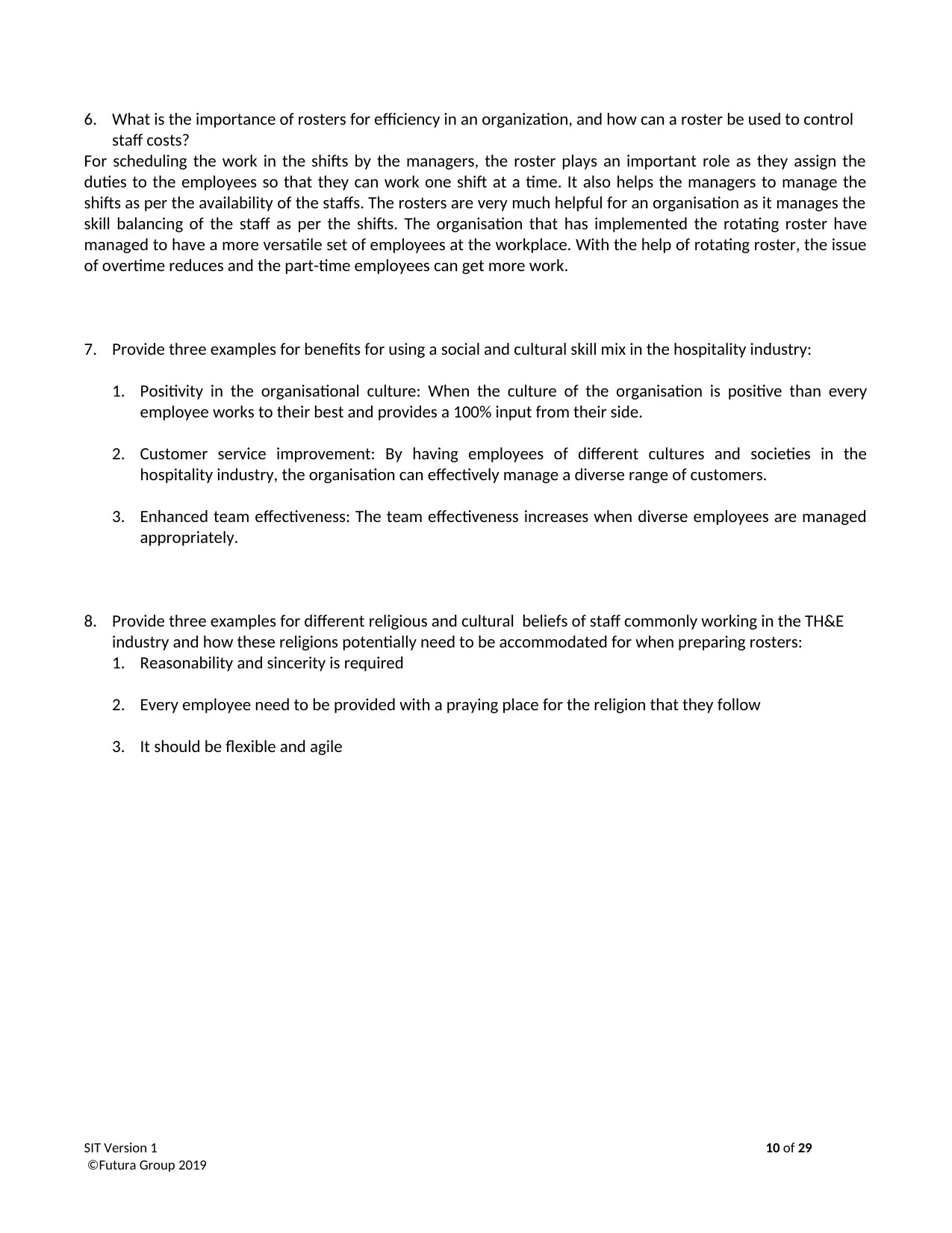
6. What is the importance of rosters for efficiency in an organization, and how can a roster be used to control
staff costs?
For scheduling the work in the shifts by the managers, the roster plays an important role as they assign the
duties to the employees so that they can work one shift at a time. It also helps the managers to manage the
shifts as per the availability of the staffs. The rosters are very much helpful for an organisation as it manages the
skill balancing of the staff as per the shifts. The organisation that has implemented the rotating roster have
managed to have a more versatile set of employees at the workplace. With the help of rotating roster, the issue
of overtime reduces and the part-time employees can get more work.
7. Provide three examples for benefits for using a social and cultural skill mix in the hospitality industry:
1. Positivity in the organisational culture: When the culture of the organisation is positive than every
employee works to their best and provides a 100% input from their side.
2. Customer service improvement: By having employees of different cultures and societies in the
hospitality industry, the organisation can effectively manage a diverse range of customers.
3. Enhanced team effectiveness: The team effectiveness increases when diverse employees are managed
appropriately.
8. Provide three examples for different religious and cultural beliefs of staff commonly working in the TH&E
industry and how these religions potentially need to be accommodated for when preparing rosters:
1. Reasonability and sincerity is required
2. Every employee need to be provided with a praying place for the religion that they follow
3. It should be flexible and agile
SIT Version 1 10 of 29
©Futura Group 2019
staff costs?
For scheduling the work in the shifts by the managers, the roster plays an important role as they assign the
duties to the employees so that they can work one shift at a time. It also helps the managers to manage the
shifts as per the availability of the staffs. The rosters are very much helpful for an organisation as it manages the
skill balancing of the staff as per the shifts. The organisation that has implemented the rotating roster have
managed to have a more versatile set of employees at the workplace. With the help of rotating roster, the issue
of overtime reduces and the part-time employees can get more work.
7. Provide three examples for benefits for using a social and cultural skill mix in the hospitality industry:
1. Positivity in the organisational culture: When the culture of the organisation is positive than every
employee works to their best and provides a 100% input from their side.
2. Customer service improvement: By having employees of different cultures and societies in the
hospitality industry, the organisation can effectively manage a diverse range of customers.
3. Enhanced team effectiveness: The team effectiveness increases when diverse employees are managed
appropriately.
8. Provide three examples for different religious and cultural beliefs of staff commonly working in the TH&E
industry and how these religions potentially need to be accommodated for when preparing rosters:
1. Reasonability and sincerity is required
2. Every employee need to be provided with a praying place for the religion that they follow
3. It should be flexible and agile
SIT Version 1 10 of 29
©Futura Group 2019
Paraphrase This Document
Need a fresh take? Get an instant paraphrase of this document with our AI Paraphraser
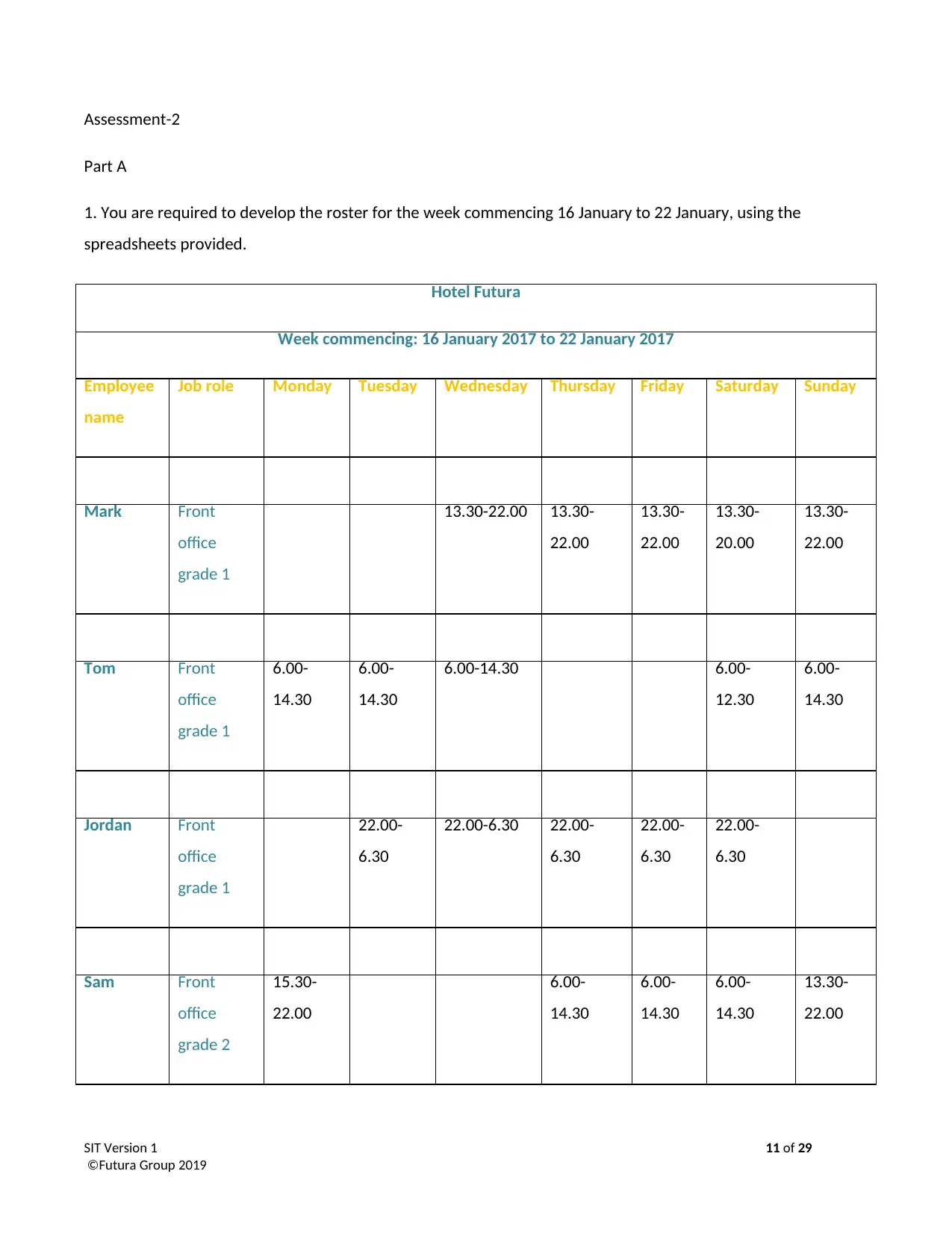
Assessment-2
Part A
1. You are required to develop the roster for the week commencing 16 January to 22 January, using the
spreadsheets provided.
Hotel Futura
Week commencing: 16 January 2017 to 22 January 2017
Employee
name
Job role Monday Tuesday Wednesday Thursday Friday Saturday Sunday
Mark Front
office
grade 1
13.30-22.00 13.30-
22.00
13.30-
22.00
13.30-
20.00
13.30-
22.00
Tom Front
office
grade 1
6.00-
14.30
6.00-
14.30
6.00-14.30 6.00-
12.30
6.00-
14.30
Jordan Front
office
grade 1
22.00-
6.30
22.00-6.30 22.00-
6.30
22.00-
6.30
22.00-
6.30
Sam Front
office
grade 2
15.30-
22.00
6.00-
14.30
6.00-
14.30
6.00-
14.30
13.30-
22.00
SIT Version 1 11 of 29
©Futura Group 2019
Part A
1. You are required to develop the roster for the week commencing 16 January to 22 January, using the
spreadsheets provided.
Hotel Futura
Week commencing: 16 January 2017 to 22 January 2017
Employee
name
Job role Monday Tuesday Wednesday Thursday Friday Saturday Sunday
Mark Front
office
grade 1
13.30-22.00 13.30-
22.00
13.30-
22.00
13.30-
20.00
13.30-
22.00
Tom Front
office
grade 1
6.00-
14.30
6.00-
14.30
6.00-14.30 6.00-
12.30
6.00-
14.30
Jordan Front
office
grade 1
22.00-
6.30
22.00-6.30 22.00-
6.30
22.00-
6.30
22.00-
6.30
Sam Front
office
grade 2
15.30-
22.00
6.00-
14.30
6.00-
14.30
6.00-
14.30
13.30-
22.00
SIT Version 1 11 of 29
©Futura Group 2019
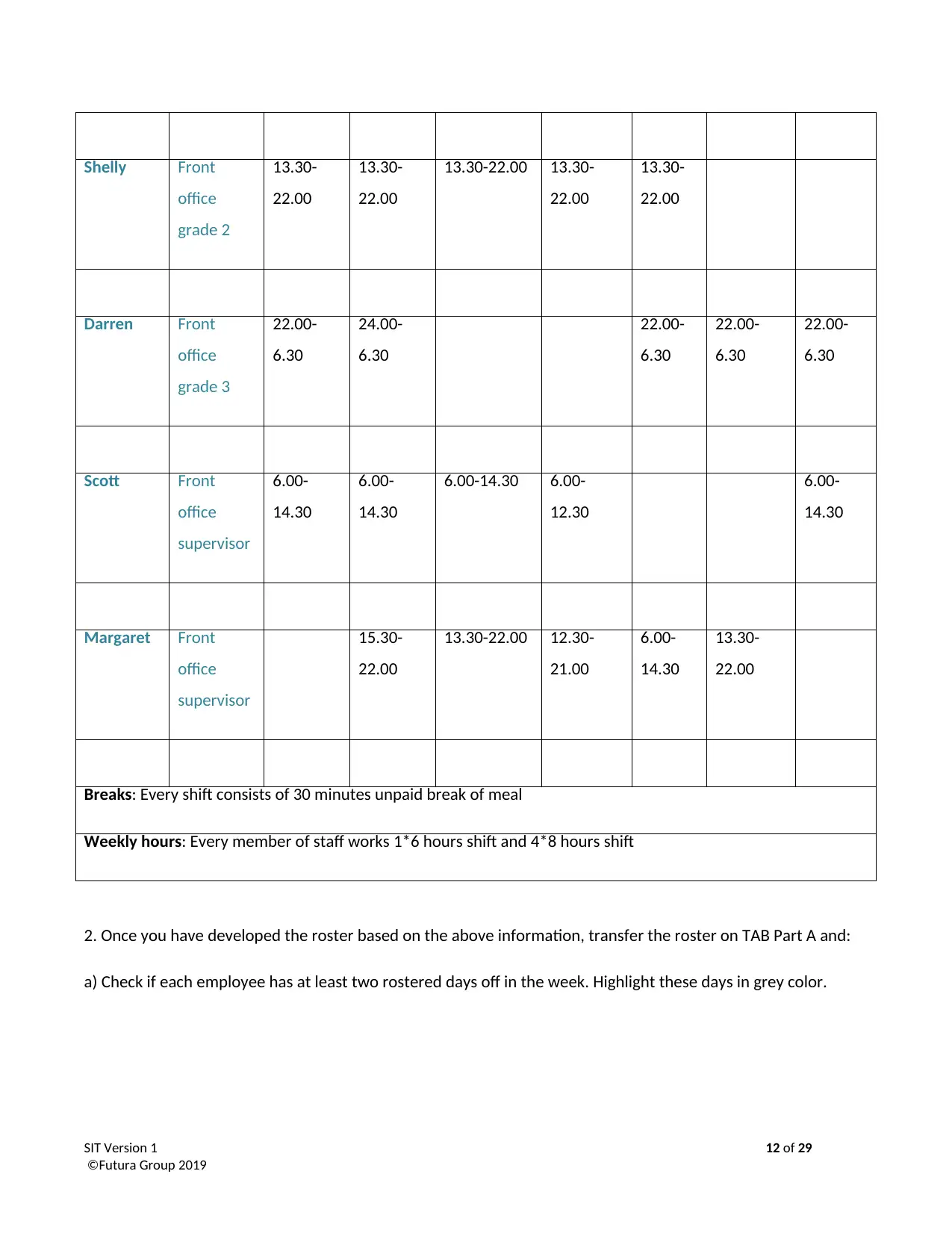
Shelly Front
office
grade 2
13.30-
22.00
13.30-
22.00
13.30-22.00 13.30-
22.00
13.30-
22.00
Darren Front
office
grade 3
22.00-
6.30
24.00-
6.30
22.00-
6.30
22.00-
6.30
22.00-
6.30
Scott Front
office
supervisor
6.00-
14.30
6.00-
14.30
6.00-14.30 6.00-
12.30
6.00-
14.30
Margaret Front
office
supervisor
15.30-
22.00
13.30-22.00 12.30-
21.00
6.00-
14.30
13.30-
22.00
Breaks: Every shift consists of 30 minutes unpaid break of meal
Weekly hours: Every member of staff works 1*6 hours shift and 4*8 hours shift
2. Once you have developed the roster based on the above information, transfer the roster on TAB Part A and:
a) Check if each employee has at least two rostered days off in the week. Highlight these days in grey color.
SIT Version 1 12 of 29
©Futura Group 2019
office
grade 2
13.30-
22.00
13.30-
22.00
13.30-22.00 13.30-
22.00
13.30-
22.00
Darren Front
office
grade 3
22.00-
6.30
24.00-
6.30
22.00-
6.30
22.00-
6.30
22.00-
6.30
Scott Front
office
supervisor
6.00-
14.30
6.00-
14.30
6.00-14.30 6.00-
12.30
6.00-
14.30
Margaret Front
office
supervisor
15.30-
22.00
13.30-22.00 12.30-
21.00
6.00-
14.30
13.30-
22.00
Breaks: Every shift consists of 30 minutes unpaid break of meal
Weekly hours: Every member of staff works 1*6 hours shift and 4*8 hours shift
2. Once you have developed the roster based on the above information, transfer the roster on TAB Part A and:
a) Check if each employee has at least two rostered days off in the week. Highlight these days in grey color.
SIT Version 1 12 of 29
©Futura Group 2019
⊘ This is a preview!⊘
Do you want full access?
Subscribe today to unlock all pages.

Trusted by 1+ million students worldwide
1 out of 29
Related Documents
Your All-in-One AI-Powered Toolkit for Academic Success.
+13062052269
info@desklib.com
Available 24*7 on WhatsApp / Email
![[object Object]](/_next/static/media/star-bottom.7253800d.svg)
Unlock your academic potential
Copyright © 2020–2025 A2Z Services. All Rights Reserved. Developed and managed by ZUCOL.


